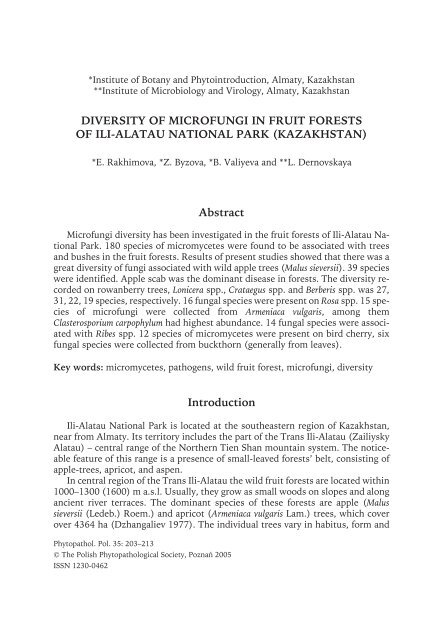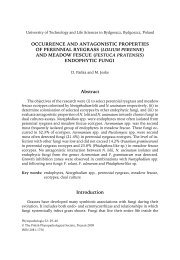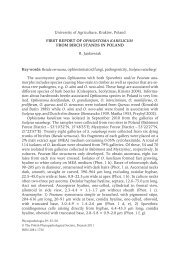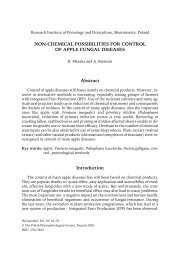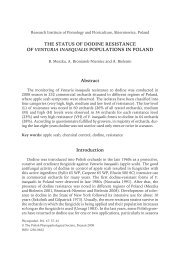diversity of microfungi in fruit forests of ili - Poznań
diversity of microfungi in fruit forests of ili - Poznań
diversity of microfungi in fruit forests of ili - Poznań
Create successful ePaper yourself
Turn your PDF publications into a flip-book with our unique Google optimized e-Paper software.
*Institute <strong>of</strong> Botany and Phyto<strong>in</strong>troduction, Almaty, Kazakhstan<br />
**Institute <strong>of</strong> Microbiology and Virology, Almaty, Kazakhstan<br />
DIVERSITY OF MICROFUNGI IN FRUIT FORESTS<br />
OF ILI-ALATAU NATIONAL PARK (KAZAKHSTAN)<br />
*E. Rakhimova, *Z. Byzova, *B. Valiyeva and **L. Dernovskaya<br />
Abstract<br />
Micr<strong>of</strong>ungi <strong>diversity</strong> has been <strong>in</strong>vestigated <strong>in</strong> the <strong>fruit</strong> <strong>forests</strong> <strong>of</strong> Ili-Alatau National<br />
Park.180 species <strong>of</strong> micromycetes were found to be associated with trees<br />
and bushes <strong>in</strong> the <strong>fruit</strong> <strong>forests</strong>.Results <strong>of</strong> present studies showed that there was a<br />
great <strong>diversity</strong> <strong>of</strong> fungi associated with wild apple trees (Malus sieversii).39 species<br />
were identified.Apple scab was the dom<strong>in</strong>ant disease <strong>in</strong> <strong>forests</strong>.The <strong>diversity</strong> recorded<br />
on rowanberry trees, Lonicera spp., Crataegus spp.and Berberis spp.was 27,<br />
31, 22, 19 species, respectively.16 fungal species were present on Rosa spp.15 species<br />
<strong>of</strong> micr<strong>of</strong>ungi were collected from Armeniaca vulgaris, among them<br />
Clasterosporium carpophylum had highest abundance.14 fungal species were associated<br />
with Ribes spp.12 species <strong>of</strong> micromycetes were present on bird cherry, six<br />
fungal species were collected from buckthorn (generally from leaves).<br />
Key words: micromycetes, pathogens, wild <strong>fruit</strong> forest, micr<strong>of</strong>ungi, <strong>diversity</strong><br />
Introduction<br />
Ili-Alatau National Park is located at the southeastern region <strong>of</strong> Kazakhstan,<br />
near from Almaty.Its territory <strong>in</strong>cludes the part <strong>of</strong> the Trans Ili-Alatau (Za<strong>ili</strong>ysky<br />
Alatau) – central range <strong>of</strong> the Northern Tien Shan mounta<strong>in</strong> system.The noticeable<br />
feature <strong>of</strong> this range is a presence <strong>of</strong> small-leaved <strong>forests</strong>’ belt, consist<strong>in</strong>g <strong>of</strong><br />
apple-trees, apricot, and aspen.<br />
In central region <strong>of</strong> the Trans Ili-Alatau the wild <strong>fruit</strong> <strong>forests</strong> are located with<strong>in</strong><br />
1000–1300 (1600) m a.s.l. Usually, they grow as small woods on slopes and along<br />
ancient river terraces.The dom<strong>in</strong>ant species <strong>of</strong> these <strong>forests</strong> are apple (Malus<br />
sieversii (Ledeb.) Roem.) and apricot (Armeniaca vulgaris Lam.) trees, which cover<br />
over 4364 ha (Dzhangaliev 1977).The <strong>in</strong>dividual trees vary <strong>in</strong> habitus, form and<br />
Phytopathol. Pol. 35: 203–213<br />
© The Polish Phytopathological Society, <strong>Poznań</strong> 2005<br />
ISSN 1230-0462
204 E. Rakhimova, Z. Byzova, B. Valiyeva and L. Dernovskaya<br />
colour <strong>of</strong> <strong>fruit</strong>, limits <strong>of</strong> <strong>fruit</strong> maturity, and susceptib<strong>ili</strong>ty to fungal pathogens.Rowan<br />
(Sorbus tianschanica Rupr.), barberry (Berberis heteropoda Schrenk), currant<br />
(Ribes meyeri Maxim), bird cherry (Padus avium Mill.), buckthorn (Rhamnus cathartica<br />
L.), different species <strong>of</strong> hawthorn (Crataegus almaatensis Pojark., C. korolkowii<br />
Henry, C. songorica Koch.), rose (Rosa alberti Regel, R. beggeriana Schrenk, R. laxa<br />
Retz., R. platyacantha Schrenk), honeysuckle (Lonicera tatarica L., L. altmanii Regel,<br />
L. stenantha Pojark.) are observed together with apple and apricot trees.<br />
The micromycetes <strong>of</strong> wild <strong>fruit</strong> <strong>forests</strong> have been described <strong>in</strong> several reports<br />
(Kravtzev 1948, Kle<strong>in</strong>er 1958, Kalymbetov 1969, Kazenas 1971).The <strong>in</strong>vestigators<br />
have noted some fungal species on trees and bushes, but mycological bio<strong>diversity</strong><br />
studies have never been undertaken.Currently there is a great <strong>in</strong>terest <strong>in</strong><br />
bio<strong>diversity</strong> issues, especially <strong>in</strong> relation to conservation <strong>of</strong> bio<strong>diversity</strong>, not least<br />
<strong>in</strong> the mycological world (Hawksworth 1991).There is also a recent <strong>in</strong>terest <strong>in</strong> the<br />
fungi associated with wild <strong>fruit</strong> trees and bushes due to their <strong>in</strong>creas<strong>in</strong>g role for the<br />
selection for immunity.<br />
The purpose <strong>of</strong> our <strong>in</strong>vestigations was to determ<strong>in</strong>ate the fungal <strong>diversity</strong> <strong>of</strong><br />
wild <strong>fruit</strong> trees and bushes <strong>in</strong> Ili-Alatau National Park <strong>in</strong> order to <strong>in</strong>crease knowledge<br />
on the contribution <strong>of</strong> micr<strong>of</strong>ungi to the fungal <strong>diversity</strong> <strong>of</strong> wild <strong>fruit</strong> <strong>forests</strong>.<br />
Material and methods<br />
The data <strong>in</strong> this study were compiled from various sources.Records <strong>of</strong> fungi reported<br />
<strong>in</strong> the literature on trees and bushes <strong>in</strong> the Trans Ili-Alatau were ut<strong>ili</strong>zed<br />
(Byzova et al. 1956–1981, Kalymbetov 1969).<br />
Leaves, <strong>fruit</strong>s, and shoots with visible symptoms <strong>of</strong> various diseases, and<br />
healthy symptomless parts <strong>of</strong> plants were collected from trees and bushes <strong>in</strong> <strong>fruit</strong><br />
<strong>forests</strong> <strong>of</strong> Trans Ili-Alatau mounta<strong>in</strong>s.The fungi associated were identified immediately,<br />
where possible.All samples were exam<strong>in</strong>ed under a microscope with<strong>in</strong> a<br />
short period.Specimens <strong>of</strong> fungi were mounted <strong>in</strong> water for exam<strong>in</strong>ation with<br />
Nomarski differential <strong>in</strong>terference contrast microscopy.The fungi were identified<br />
us<strong>in</strong>g keys and relevant references (Byzova et al.1956–1981).All exam<strong>in</strong>ed samples<br />
bear<strong>in</strong>g fungi identified (dry materials) were deposited <strong>in</strong> Herbarium Department<br />
(Institute <strong>of</strong> Botany and Phyto<strong>in</strong>troduction).Non-sporulat<strong>in</strong>g material was<br />
kept <strong>in</strong> humid boxes at ambient temperature and exam<strong>in</strong>ed regularly for fungal<br />
growth for five weeks.Some fungi were isolated and cultured on malt-yeast extract<br />
agar medium (2% malt extract, 0.2% yeast extract, 1.5% agar) at 23°C for 5–30<br />
days for morphological exam<strong>in</strong>ation.<br />
Results<br />
180 species <strong>of</strong> micromycetes were found to be associated with trees and bushes<br />
<strong>in</strong> the <strong>fruit</strong> <strong>forests</strong> (Table 1).Results <strong>of</strong> present studies showed that there was a
Diversity <strong>of</strong> micr<strong>of</strong>ungi <strong>in</strong> <strong>fruit</strong> <strong>forests</strong>... 205<br />
Table 1<br />
List <strong>of</strong> species <strong>of</strong> micromycetes found on trees and bushes <strong>of</strong> <strong>fruit</strong> <strong>forests</strong><br />
<strong>in</strong> Ili-Alatau National Park: Malus sieversii (M), Armeniaca vulgaris (A), Sorbus<br />
tianschanica (S), Crataegus spp. (C), Rosa spp. (R), Padus avium (P), Lonicera spp.<br />
(L), Ribes meyeri (Ri), Rhamnus cathartica (Ra), Berberis heteropoda (B)<br />
No.Fungus<br />
M A S<br />
Host plants<br />
C R P L Ri Ra B<br />
1 2 3 4 5 6 7 8 9 10 11 12<br />
1 Alternaria alternata (Fr.) Keissl. +<br />
2 Alternaria mali Roberts +<br />
3 Alternaria tenuis Nees +<br />
4 Anthostoma xylostei Sacc. +<br />
5 Ascochyta mali Ell. & Ev. +<br />
6 Aspergillus glaucus L<strong>in</strong>k +<br />
7 Botrytis c<strong>in</strong>erea Pers. + + +<br />
8 Calosphaeria kriegeriana Niessl. +<br />
9 Camarosporium polymorphum (De Not.) Sacc. +<br />
10 Cercospora cerasella Sacc. +<br />
11 Cercospora mali Ell. & Ev. +<br />
12 Cercospora ribicola Ell. & Ev. +<br />
13 Cic<strong>in</strong>nobolus cesatii Sacc. +<br />
14 Cladosporium herbarum (Pers.) L<strong>in</strong>k + + +<br />
15 Cladosporium stenosporum B. & C. Narth. +<br />
16 Cladosporium trichophilum Greene +<br />
17 Clasterosporium carpophilum (Lev.) Aderh. + +<br />
18 Coniochaeta ligniaria (Chev.) Mass. + +<br />
19 Coniochaeta niesslii (Auers.) Arx. & Muller +<br />
20 Coniothecium epidermidis Cord. +<br />
21 Coniothecium <strong>in</strong>tricatum Peck +<br />
22 Coniothecium olivaceum McAlp. + +<br />
23 Coniothecium pulverulentum Karst. +<br />
24 Coniothecium ribes Karst. +<br />
25 Coniothyrium berberidis Fautr. +<br />
26 Coniothyrium olivaceum Bon. +<br />
27 Cucurbitaria acervata (Fr.) Ces. +<br />
28 Cucurbitaria berberidis (Fr.) Gray +<br />
29 Cucurbitaria crataegi (Schw.) Ell. & Ev. +<br />
30 Cucurbitaria delitescens Sacc. +<br />
31 Cucurbitaria ribis Niessl. +<br />
32 Cucurbitaria sorbi Karst. +<br />
33 Cucurbitaria subcespitosa Otth. +
206 E. Rakhimova, Z. Byzova, B. Valiyeva and L. Dernovskaya<br />
Table 1 – cont.<br />
1 2 3 4 5 6 7 8 9 10 11 12<br />
34 Cucurbitaria vestita Jacz. +<br />
35 Cyl<strong>in</strong>drosporium brevisp<strong>in</strong>a Dearn. +<br />
36 Cytospora capitata Sacc. & Schulz. +<br />
37 Cytospora carphosperma Fr.+<br />
38 Cytospora c<strong>in</strong>cta Sacc. +<br />
39 Cytospora microspora (Cda.) Rab. + +<br />
40 Cytospora oxyacanthae Rab. +<br />
41 Cytospora personata Fr. +<br />
42 Cytospora rosarum Grev. +<br />
43 Cytospora rubescens Fr. +<br />
44 Dald<strong>in</strong>ia concentrica Ces. +<br />
45 Dendrophoma pulvis-pyrius Sacc. +<br />
46 Diaporthe cryptyca Nits. +<br />
47 Diatripe stigma (Fr.) Fr. + + +<br />
48 Diatripella verrucaeformis (Ehrh.) Nits. +<br />
49 Didymosphaeria oxycedri Fabre +<br />
50 Diplodia griffoni Sacc. +<br />
51 Dothiorella berengeriana Sacc. +<br />
52 Dothiorella pyrenophora (Karst.) Sacc. +<br />
53 Dothiorella sorb<strong>in</strong>a Karst. +<br />
54 Entomosporium maculatum Lev. + +<br />
55 Euthypella padi (Karst.) Sacc. +<br />
56 Fumago vagans Pers. ex Sacc. +<br />
57 Fusicladium lonicerae Vassjag. +<br />
58 Fusicladium orbiculatum (Desm.) Thum. +<br />
59 Gloeosporium crataeg<strong>in</strong>um Sacc. +<br />
60 Gloeosporium ribis (Lib.) Mont. +<br />
61 Gloeosporium sorbi Rostr. +<br />
62 Gymnosporangium confusum Plowr. +<br />
63 Gymnosporangium juniper<strong>in</strong>um (L.) Mart. + +<br />
64 Hendersonia sarmentorum West. +<br />
65 Hymenoscypha virgaltorum (Vahl.) Rehm +<br />
66 Lasiobotrys lonicerae (Fr.) Kunze +<br />
67 Lasiosphaeria hirsuta (Fr.) Ces. & De Not. +<br />
68 Leptostroma herbarum L<strong>in</strong>k +<br />
69 Leptothyrium pomi Sacc. +<br />
70 Leucostoma auerswaldii (Nits.) Hoehn. +<br />
71 Leucostoma persoonii (Nits.) Hoehn. +<br />
72 Lophiostoma vagans Fabre +
Diversity <strong>of</strong> micr<strong>of</strong>ungi <strong>in</strong> <strong>fruit</strong> <strong>forests</strong>... 207<br />
Table 1 – cont.<br />
1 2 3 4 5 6 7 8 9 10 11 12<br />
73 Lophodermium hysterioides (Pers.) Sacc.<br />
74 Macrosporium commune Rab.+<br />
+<br />
75 Marsson<strong>in</strong>a lonicerae (Harkn.) Magn. +<br />
76 Marsson<strong>in</strong>a rosae (Lib.) Died. +<br />
77 Melanomma rul<strong>in</strong>um Karst. +<br />
78 Melasmia lonicerae Jacz. +<br />
79 Melomastia mastoidea (Fr.) Schroet. +<br />
80 Microsphaera berberidis (DC.) Lev. +<br />
81 Microsphaera friesii Lev. +<br />
82 Microsphaera lonicerae W<strong>in</strong>ter +<br />
83 Microsphaera magnusii Blumer +<br />
84 Mollisia lignicola Phiel. + +<br />
85 Mon<strong>ili</strong>a c<strong>in</strong>erea Pers.+ +<br />
86 Mon<strong>ili</strong>a crataegi Died. +<br />
87 Mon<strong>ili</strong>a fructigena Pers. +<br />
88 Mon<strong>ili</strong>a l<strong>in</strong>thartiana Sacc. +<br />
89 Mucor mucedo L. +<br />
90 Mycosphaerella cerasella Aderh. +<br />
91 Mycosphaerella grossulariae (Fr.) L<strong>in</strong>d. +<br />
92 Mycosphaerella pomi (Pass.) L<strong>in</strong>k +<br />
93 Mycosphaerella ribis (Fuck.) Feltg. +<br />
94 Mycosphaerella rosigena (Ell. & Ev.) Stev. +<br />
95 Nectria c<strong>in</strong>nabar<strong>in</strong>a (Fr.) Fr.<br />
96 Nectria galligena Bres.+<br />
+<br />
97 Nectria ribis (Tode) Rab. +<br />
98 Oedocephalum globuliferum Bref. +<br />
99 Ovularia berberidis Rab. +<br />
100 Penicillium communis Rob. +<br />
101 Penicillium expansum Fr. +<br />
102 Phoma aucupariae Bres. +<br />
103 Phoma crataegi Sacc. +<br />
104 Phoma m<strong>in</strong>utula Sacc. +<br />
105 Phoma xylostei Cke. & Harkn. +<br />
106 Phragmidium devastatrix Sorok<strong>in</strong> +<br />
107 Phragmidium disciflorum (Tode) James +<br />
108 Phragmidium kamtschatkae (Anders.) Arth. & Cumm. +<br />
109 Phragmidium rosae-acicularis Liro +<br />
110 Phragmidium rosae-lacerantis Dietel +<br />
111 Phragmidium tuberculatum J. Muller +
208 E. Rakhimova, Z. Byzova, B. Valiyeva and L. Dernovskaya<br />
Table 1 – cont.<br />
1 2 3 4 5 6 7 8 9 10 11 12<br />
112 Phyllact<strong>in</strong>ia suffulta Sacc.f.mali Kalymbetov +<br />
113 Phyllact<strong>in</strong>ia suffulta Sacc. f. oxyacanthae Sacc. +<br />
114 Phyllact<strong>in</strong>ia suffulta Sacc. f. ribesii Jacz. + +<br />
115 Phyllosticta berberidis Rab.<br />
116 Phyllosticta briardi Sacc.+<br />
+<br />
117 Phyllosticta mali Prill. & Del. +<br />
118 Phyllosticta michailowskoensis Elenk. & Ohl. +<br />
119 Phyllosticta rhamnicola Desm. +<br />
120 Phyllosticta rosarum Pass. +<br />
121 Platystomum compressum (Pers.) Trev. +<br />
122 Pleospora delicatula (Vest.) Wehm. +<br />
123 Pleospora herbarum (Fr.) Rab. +<br />
124 Pleospora <strong>in</strong>fernalis (Niessl.) Wehm. +<br />
125 Pleospora orbicularis Auers. +<br />
126 Pleospora oxyacanthae Wallr. +<br />
127 Pleospora scrophulariae (Desm.) Hohn.<br />
128 Podosphaera leucotricha Salm.+<br />
+<br />
129 Podosphaera oxyacanthae de Bary f. crataegi Jacz. +<br />
130 Podosphaera oxyacanthae de Bary f. sorbi Jacz. +<br />
131 Podosphaera tridactyla de Bary f. padi Jacz. +<br />
132 Polystigma ochraceum (Wahl.) Sacc. +<br />
133 Polystigm<strong>in</strong>a ochraceum Sacc. +<br />
134 Polystigm<strong>in</strong>a rubra (Desm.) Sacc. +<br />
135 Pucc<strong>in</strong>ia coronifera Kleb. +<br />
136 Pucc<strong>in</strong>ia festucae Plowr. +<br />
137 Pucc<strong>in</strong>ia gram<strong>in</strong>is Fuckl. +<br />
138 Pucc<strong>in</strong>ia longirostis Komar. +<br />
139 Pucc<strong>in</strong>ia ribesi-cor<strong>ili</strong>s Kleb. +<br />
140 Ramularia lonicerae Vogl. +<br />
141 Rhabdospora lonicerae (Cke. & Ell.) Sacc. +<br />
142 Rhabdospora xylostei Lamb. & Fautr. +<br />
143 Rhytisma lonicerae P. Henn. +<br />
144 Rosell<strong>in</strong>ia rosarum Niessl. +<br />
145 Sclerotium pir<strong>in</strong>um Fr. +<br />
146 Septoria aucuparicola Oud. +<br />
147 Septoria crataegi Kickx. +<br />
148 Septoria crataegicola A. Bond. & Tranz. +<br />
149 Septoria ribis Desm. +<br />
150 Septoria sorbi Lasch. ex Sacc. +<br />
151 Septoria xylostei Sacc. & W<strong>in</strong>t. +
Diversity <strong>of</strong> micr<strong>of</strong>ungi <strong>in</strong> <strong>fruit</strong> <strong>forests</strong>... 209<br />
Table 1 – cont.<br />
1 2 3 4 5 6 7 8 9 10 11 12<br />
152 Sphaerotheca pannosa Lev. var. rosae Woron.<br />
153 Spilocaea pomi Fr.+<br />
+<br />
154 Stigm<strong>in</strong>a carpophila (Lev.) M. Ellis +<br />
155 Strickeria cerasi Feltg. +<br />
156 Strickeria megastegia (Ell. & Ev.) Frol. +<br />
157 Strickeria melanospora Kirschst.+ +<br />
158 Strickeria patellaris (Karst.) Byzova +<br />
159 Tapesia rosae Pers. + +<br />
160 Taphr<strong>in</strong>a padi (Jacz.) Mix. +<br />
161 Thecopsora padi (Kze. & Schm.) Kleb. +<br />
162 Thyridaria pulveraceae (Karst.) Sacc. +<br />
163 Thyronectria berol<strong>in</strong>ensis (Sacc.) Seaver +<br />
164 Trematosphaeria errabunda Fabre +<br />
165 Tremella mesenterica Retz. ex Fr. +<br />
166 Trichothecium roseum L<strong>in</strong>k + +<br />
167 Tubercularia confluens Pers. +<br />
168 Tubercularia libertiana Paola +<br />
169 Tubercularia liceoides Fr.+<br />
170 Tubercularia m<strong>in</strong>or L<strong>in</strong>k +<br />
171 Tubercularia persic<strong>in</strong>a (Ditm.) Sacc. +<br />
172 Tubercularia rhamni Paoli +<br />
173 Tubercularia sarmentorum Fr. +<br />
174 Tubercularia vulgaris Fr. + + +<br />
175 Valsa ambiens (Fr.) Fr. + +<br />
176 Valsa leucostoma Fr. +<br />
177 Venturia <strong>in</strong>aequalis (Cke.) W<strong>in</strong>t. +<br />
178 Vermicularia mali (Woronich.) Vassil. +<br />
179 Xylaria hypoxylon (L.) Grev. +<br />
180 Zignoella pulviscula (Curr.) Sacc. +<br />
great <strong>diversity</strong> <strong>of</strong> fungi associated with apple trees.39 species belong<strong>in</strong>g to 36 genera<br />
were identified (Fig.1).Most <strong>of</strong> them were collected from the leaves, and<br />
Spilocaea pomi Fr.(apple scab fungus) was widely distributed.This species attacked<br />
leaves and <strong>fruit</strong> <strong>of</strong> host, result<strong>in</strong>g <strong>in</strong> light olive-brown spots gradually expand<strong>in</strong>g<br />
on the surface <strong>of</strong> apple leaves or <strong>fruit</strong>s.Infected plants that were weakened <strong>in</strong> this<br />
way tended to be susceptible to secondary pathogens.Sometimes apple scab<br />
caused defoliation.Scab fungus was the most common pathogen on apple trees <strong>in</strong><br />
all gorges <strong>of</strong> the Trans Ili-Alatau.90% <strong>of</strong> wild apple trees were <strong>in</strong>fected by scab fungus.Occurrence<br />
and <strong>in</strong>tensity <strong>of</strong> disease varied depend<strong>in</strong>g on climatic conditions
210 E. Rakhimova, Z. Byzova, B. Valiyeva and L. Dernovskaya<br />
Fig. 1. Number <strong>of</strong> fungal species and genera associated with trees and bushes <strong>in</strong> <strong>fruit</strong> <strong>forests</strong><br />
dur<strong>in</strong>g the grow<strong>in</strong>g period, the aggressiveness <strong>of</strong> pathogen, and the susceptib<strong>ili</strong>ty<br />
<strong>of</strong> <strong>in</strong>dividual host plant.<br />
Apple trees were also affected by rust disease (causal agent – Gymnosporangium<br />
juniper<strong>in</strong>um (L.) Mart). The <strong>in</strong>itial <strong>in</strong>dications <strong>of</strong> rust <strong>in</strong>fection on apple leaves were<br />
the presence <strong>of</strong> dark orange spots.Spermogonia and aecia were observed on apple<br />
leaves soon after beg<strong>in</strong>n<strong>in</strong>g <strong>of</strong> summer. Podosphaera leucotricha (Ell.& Ev.) Salm.<br />
(powdery mildew fungus) damaged apple leaves, which became white, dry, and<br />
mildewed.Like apple scab, powdery mildew caused defoliation <strong>of</strong> susceptible<br />
forms.Infected trees were found <strong>in</strong> all gorges.Hyperparasite Cic<strong>in</strong>nobolus cesatii De<br />
Bary was found occasionally <strong>in</strong> hyphae <strong>of</strong> powdery mildew fungus. Mycosphaerella<br />
pomi (Pass.) L<strong>in</strong>k, Cercospora mali Ell.& Ev., Phyllosticta mali Prill.& Del., Ascochyta<br />
mali Ell.& Ev., and species belong<strong>in</strong>g to the genus Alternaria attacked ma<strong>in</strong>ly (or<br />
only) leaves <strong>of</strong> apple.Leaf spots were circular to irregular, necrotic, yellow, brown,<br />
or gray-brown with dark brown marg<strong>in</strong>.Conidiomata <strong>of</strong> Phyllosticta and Ascochyta,<br />
and ascomata <strong>of</strong> Mycosphaerella were visible as dots, scattered with<strong>in</strong> the leaf spot.<br />
Most <strong>of</strong> other fungi identified were found occasionally.<br />
The <strong>diversity</strong> <strong>of</strong> fungi on honeysuckle was 31 species.Powdery mildew fungi<br />
(Microsphaera lonicerae W<strong>in</strong>ter, M. magnusii Blumer) were the dom<strong>in</strong>ant species on<br />
honeysuckle leaves.The occurrence <strong>of</strong> Rhytisma lonicerae P.Henn., Pucc<strong>in</strong>ia<br />
longirostis Komar., P. festucae Plowr., Septoria xylostei Sacc.& W<strong>in</strong>t., Melasmia<br />
lonicerae Jack., Marsson<strong>in</strong>a lonicerae (Harkn.) Magn., Fusicladium lonicerae Vassjag.was<br />
associated with leaf spots <strong>of</strong> host.
Diversity <strong>of</strong> micr<strong>of</strong>ungi <strong>in</strong> <strong>fruit</strong> <strong>forests</strong>... 211<br />
27 species <strong>of</strong> micromycetes were found to be associated with rowan.The most<br />
important fungal pathogens <strong>of</strong> rowan were Gymnosporangium juniperi L<strong>in</strong>k and<br />
Fusicladium orbiculatum (Desm.) Thum., caus<strong>in</strong>g rust and scab, respectively. 22 fungal<br />
species on hawthorn were identified, among them Phyllact<strong>in</strong>ia suffulta Sacc.f.<br />
oxyacantha Sacc. and Gymnosporangium confusum Plovr. were widely distributed.<br />
The fungal <strong>diversity</strong> recorded on barberry, rose, and apricot was 19, 16, 15 species,<br />
respectively.Powdery mildew was the dom<strong>in</strong>ant disease on barberry leaves.<br />
Most <strong>of</strong> other fungi identified were found occasionally.Rust and powdery mildew<br />
were the dom<strong>in</strong>ant diseases on rose leaves. Phragmidium, Sphaerotheca, and<br />
Marsson<strong>in</strong>a were the dom<strong>in</strong>ant genera with high abundance. Phragmidium was also<br />
the genus with the most number <strong>of</strong> species: there were six species <strong>of</strong> this genus.<br />
Phragmidium devastatrix Sorok<strong>in</strong>, P. disciflorum (Tode) James., P. kamtschatkae (Ander.)<br />
Arth., P. rosae-acicularis Liro, P. rosae-lacerantis Diet., P. tuberculatum Muller were collected<br />
from leaves, stems and <strong>fruit</strong>s <strong>of</strong> host plant, P. disciflorum be<strong>in</strong>g predom<strong>in</strong>ant.<br />
Sphaerotheca pannosa Lev.var. rosae Wor.(anamorph – Oidium erysiphoides Fries.),<br />
powdery mildew fungus, was the common pathogen <strong>of</strong> Rosa species attack<strong>in</strong>g leaves<br />
and young stems <strong>of</strong> host plants.Widespread species, Marsson<strong>in</strong>a rosae (Lib.) Died, attacked<br />
only senescent leaves <strong>of</strong> host plant, result<strong>in</strong>g <strong>in</strong> radial and stellate black (or<br />
purple brown) spots with various sizes.Among fungal species collected from apricot,<br />
Clasterosporium carpophyllum Aderh.had the highest abundance.<br />
The <strong>diversity</strong> <strong>of</strong> fungi associated with currant was 14 species, among them<br />
Pucc<strong>in</strong>ia ribesi-cor<strong>ili</strong>s Kleb.and Cercospora ribicola Ell.& Ev.were dom<strong>in</strong>ant.Both species<br />
attacked ma<strong>in</strong>ly (or only) leaves <strong>of</strong> currant.<br />
12 species <strong>of</strong> micromycetes were present on bird cherry. Polystigma ochraceum<br />
Sacc.was dom<strong>in</strong>ant, attack<strong>in</strong>g only leaves <strong>of</strong> host plant.Leaf spots were circular<br />
and orange-red with a prom<strong>in</strong>ent marg<strong>in</strong>.Six fungal species were collected from<br />
buckthorn (generally from leaves).<br />
Discussion<br />
Overall 180 species <strong>of</strong> micr<strong>of</strong>ungi occurr<strong>in</strong>g on trees and bushes <strong>in</strong> wild <strong>fruit</strong><br />
<strong>forests</strong> <strong>of</strong> Ili-Alatau National Park were identified, whereas Kazenas (1971) was<br />
able to identify 80 different species and Kalymbetov (1969) described 131 species.<br />
In another <strong>in</strong>vestigation <strong>of</strong> neighbour<strong>in</strong>g territories, Mosolova (1987), analyz<strong>in</strong>g<br />
micromycetes on trees and bushes <strong>in</strong> Kirghizia, found 133 species, among them<br />
seven species were collected from apple, 21 species – from roses, 11 species – from<br />
apricot, 15 species – from hawthorn, four species – from bird cherry, 11 species –<br />
from rowan, 15 species – from barberry, 13 species – from currant, 33 species –<br />
from honeysuckle, three species – from buckthorn.It is remarkable that so few<br />
micromycetes were found on apple trees, bird cherry and buckthorn <strong>in</strong> Kirghizia,<br />
consider<strong>in</strong>g that they were so frequently recorded on the same plants <strong>in</strong><br />
Kazakhstan.The dom<strong>in</strong>ant fungi on different host plants were similar <strong>in</strong><br />
Kazakhstan and <strong>in</strong> Kirghizia.For example, Spilocaea pomi Fr.was commonly found
212 E. Rakhimova, Z. Byzova, B. Valiyeva and L. Dernovskaya<br />
on apple trees, Phragmidium species – on roses.But other fungi associated with<br />
trees and bushes were significally different <strong>in</strong> Kazakhstan and <strong>in</strong> Kirghizia.For example,<br />
six species <strong>of</strong> Phragmidium was commonly found on roses <strong>in</strong> Kazakhstan,<br />
while Mosolova (1987) reported four species <strong>of</strong> this genus <strong>in</strong> Kirghizia.Some parts<br />
<strong>of</strong> these differences regard<strong>in</strong>g fungal species composition on different trees and<br />
bushes may be due to natural factors such as climate, microclimatic and edaphic<br />
characteristics, altitud<strong>in</strong>al zonality, others to anthropogenic <strong>in</strong>fluences.<br />
The results <strong>of</strong> the present study showed that several fungal species were common<br />
to more than one host.Some <strong>of</strong> species such as Botrytis c<strong>in</strong>erea Pers., Diatripe<br />
stigma (Fr.) Fr. and some species <strong>of</strong> Tubercularia, were not host specific and were<br />
collected from different host plants.Host-specific species were primary l<strong>in</strong>ked to<br />
liv<strong>in</strong>g leaves, and were then represented by obligate, biotrophic pathogens.<br />
Acknowledgements<br />
Authors are grateful to D.Korenev from Institute <strong>of</strong> Microbiology and Virology,<br />
Almaty, Kazakhstan, for technical assistance.<br />
Literature<br />
Byzova Z.M., Vasyag<strong>in</strong>a M.P., Deeva N.G., Kalymbetov B.K., Pisareva H.F., Shvarzman S.R.,<br />
1956–1981: Flora sporovykh rasteniy Kazakhstana. Vol. 1, 3, 5, 7–9, 12. Nauka, Alma-Ata.<br />
Dzhangaliev A.D., 1977: Dikaya yablonya Kazakhstana. Nauka, Alma-Ata.<br />
Hawksworth D.L., 1991: The fungal dimension <strong>of</strong> bio<strong>diversity</strong>: magnitude, significance, and conservation.<br />
Mycol. Res. 95: 641–655.<br />
Kalymbetov B.K., 1969: Mik<strong>of</strong>lora Za<strong>ili</strong>yskogo Alatau. Nauka, Alma-Ata.<br />
Kazenas L.D., 1971: Bolezni dikikh plodovykh i yagodnykh rasteniy. Kaynar, Alma-Ata.<br />
Kle<strong>in</strong>er B.D., 1958: Bolezni dikikh plodovykh derev’ev. Dokl. Sredneaziatsk. nauchn.-issled. <strong>in</strong>st. lesa<br />
(Tashk.) 1: 133–138.<br />
Kravtzev B.T., 1948: Gribnye bolezni dikoy yabloni. In: Trudy Almat<strong>in</strong>skogo zapovednika. Nauka,<br />
Alma-Ata: 135–144.<br />
Mosolova S.N., 1987: Mikromytzety derev’ev i kustarnikov Chuyskoy dol<strong>in</strong>y i severnogo sklona<br />
Kirgizskogo khrebta. Ilim, Frunze.<br />
Authors’ addresses: Dr Elena Rakhimova,<br />
Dr Zoya Byzova,<br />
Dr Balsheker Valiyeva,<br />
Institute <strong>of</strong> Botany and Phyto<strong>in</strong>troduction,<br />
ul. Timiryazeva 36 D,<br />
480-090 Almaty,<br />
Kazakhstan<br />
e-mail: evrakhim@mail.ru
Accepted for publication: 30.03.2005<br />
Diversity <strong>of</strong> micr<strong>of</strong>ungi <strong>in</strong> <strong>fruit</strong> <strong>forests</strong>... 213<br />
Dr Ludmila Dernovskaya,<br />
Institute <strong>of</strong> Microbiology and Virology,<br />
ul. Bogenbay-Batyr 103,<br />
480-100 Almaty,<br />
Kazakhstan


